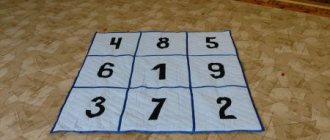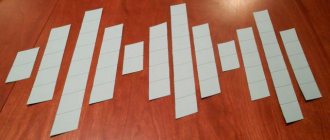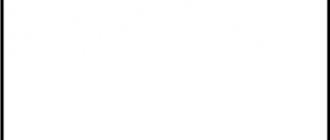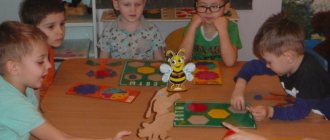Does your child know numbers? Have you already mastered counting within 10? It's time to move on! Learning to solve examples in mathematics for preschoolers. This skill - solving mathematical examples - is very important to teach a child before school. Solving examples trains the future student's attention, memory and develops logical thinking.
Development and education of children from 2 to 11 years old in a playful way
Start practicing right now
Start practicing
Examples in pictures
Examples in pictures are suitable for beginner mathematicians. A visual image will help the child better see the cause-and-effect relationship of changes in quantity.
Download worksheets for solving addition and subtraction examples.
You will find even more examples for preschoolers in the section Adding and Subtracting
Mathematical progression and number sequence for children
The number series is a kind of exercise in mathematical logic, the first acquaintance with the sequence of numbers. Part of the exercise is addition, part is subtraction. That is, it is an arithmetic progression.
These cards are designed to help children learn numbers, counting, subtracting and adding. Kids can review these math concepts at home in a fun way. Teachers can also use them in the classroom.
Examples within 10
Gradually, the child will be better and better at calculating within 10. To learn how to “crack” examples like nuts, you need to solve a lot. But simply solving the same type of examples is boring. Math should be interesting!
So that your child can practice writing examples at any time, we have come up with ready-made tasks for you. Just download, print and get started!
Print math tasks: sudoku, mazes, puzzles
Color Sudoku is solved in the same way as number Sudoku, but in this case we use colors. Here are more children's Sudoku without numbers and rules for solving them.
Mazes help develop cognitive abilities of attention. These labyrinths include images related to the sea.
Math puzzles are a way to introduce children to equations and are also great exercises in deduction and logic. Children must determine the value of one of the ice creams using their mental abilities and mathematical logic. More mazes for children.
Examples for addition and subtraction up to 10
Preparing for school is necessary and important! The ability to quickly solve examples within 10 will be very useful for your child at school. To practice this skill, we have prepared practice sheets with examples of addition and subtraction within 10.
Solving such examples at speed is not only interesting, but also extremely useful for a future first-grader. Print out the exercise sheets and explain the task. The child needs to solve all the examples on one sheet as quickly as possible. To track your progress, write down the due date and time on your worksheet.
After completing the task, generously praise your child for his efforts, even if he made some mistakes, because he is just learning!
After some time, you can print this sheet again and have a math competition. Therefore, keep all printouts and assignments already completed to assess your child's progress.
Arithmetic problems for the preparatory group
- Problems to find the sum and remainder
- problem to find the sum:
Misha and Vitya went fishing. Misha caught 4 fish, and Vitya – 2. How many fish did the boys catch together?
Solution:
4+2=6
Answer:
together the boys caught 6 fish.
- task to find the remainder:
There were 5 apples in the vase. Masha ate 2 apples. How many apples are left in the vase?
Solution:
5–2=3
Answer:
There are 3 apples left in the vase.
- Problems to find unknown components
- task to find the first term:
Nina sculpted several berries and 1 bear from plasticine. In total she sculpted 5 figures. How many berries did Nina make?
Solution:
5–1=4
Answer:
Nina sculpted 4 berries.
- task to find the second term:
Vitya sculpted 4 bears and several bunnies. In total he sculpted 7 figures. How many bunnies did Vitya sculpt?
Solution:
7–4=3
Answer:
Vitya sculpted 3 bunnies
- task to find the minuend:
The children made several garlands for the Christmas tree. One of them has already been hung on the tree, they have 3 garlands left. How many garlands did the children make?
Solution:
3+1=4
Answer:
The children made 4 garlands.
- task to find the subtrahend:
The children made 7 garlands for the Christmas tree. When they hung several garlands on the tree, they had 1 garland left. How many garlands did you hang on the Christmas tree?
Solution:
7–1=6
Answer:
6 garlands were hung on the Christmas tree.
- Problems to find more (less) by several units
- task to find more by several units:
There were plums and peaches on the plate. There were 6 plums, and 2 more peaches. How many peaches were on the plate?
Solution:
6+2=8
Answer:
There were 8 peaches on the plate.
- The task is to find several units less:
Lena was setting the table. There were 3 blue cups and 1 less yellow cup. How many yellow cups were on the table?
Solution:
3–1=2
Answer:
there were 2 yellow cups on the table.
- Versatile comparison problems
- how much more:
For the holiday, Misha cut out 4 flags, and Masha - 6 flags. How many more flags did Masha cut out?
Solution:
6–4=2
Answer:
Masha cut out 2 more flags than Misha.
- how much less:
Grandmother and mother went to the store. Grandmother bought 5 oranges, and mother bought 4. How many fewer oranges did mother buy?
Solution:
5–4=1
Answer:
Mom bought 1 orange less than grandma.
- Reciprocal problems
- Vova had 6 red stamps and 4 blue ones. How many stamps did Vova have in total?
Solution:
6+4=10
Answer:
Vova had 10 marks.
- Vova had 10 marks. 6 stamps are red, the rest are blue. How many blue stamps did Vova have?
Solution:
10–6=4
Answer:
Vova had 4 blue stamps.
- Vova had 10 marks. Several stamps were red and 4 stamps were blue. How many red stamps did Vova have?
Solution:
10–4=6
Answer:
Vova had 6 red stamps
- Indirect tasks
9 children were placed in two boats: several children sat in a large boat, and 4 children sat in a small one. How many children got into the big boat?
Solution:
9–4=5
Answer:
5 children got into a large boat.
Tasks “Connect by numbers and numbers”
One of the biggest benefits of the Number Matching activity is that you can do several things at once. On the one hand, with connect-the-dot drawings, we work on fine motor skills (graphomotor skills), on the other hand, we work on numbers. These activities help children learn to count. When the dots are connected, a shape is formed that can be colored.




